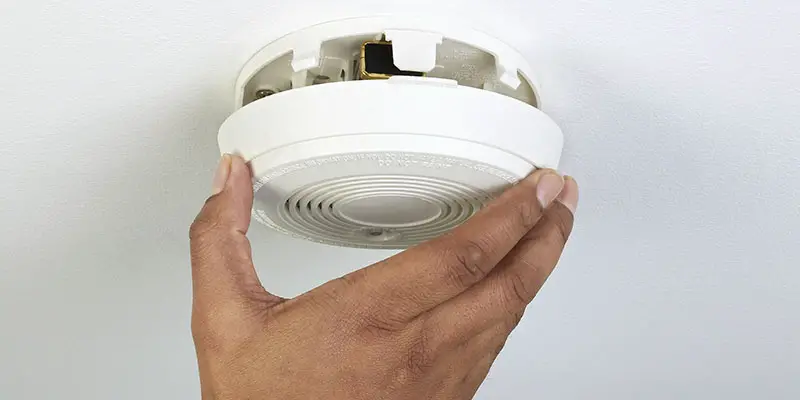An electronic fire safety equipment known as a smoke detector detects smoke automatically, a vital sign of a fire, and emits a warning sound to the residents of the building. As a part of the central fire alarm system of a building, commercial and industrial smoke detectors send a signal to a fire alarm control panel. A smoke detection system is required in every workplace by law. Home smoke detectors, often known as smoke alarms, locally sound an alert that may also be visible. They might be standalone battery-powered units or a network of hardwired (mains-powered) devices that are connected and powered by batteries. Both after significant renovations and in every new construction, the latter must be added. On average, smoke detectors last for 10 years. Periodic testing and battery replacement are required for detectors. Radioactive substance called Americium is present in ionization processes. Americium’s radiation is normally not dangerous, however, children’s mouth or lung absorption could have negative health effects. Some detectors, when used at home, combine both technologies with heat detectors to increase their accuracy.
How do smoke detectors work?
There is a tiny source of Americium-241, a byproduct of nuclear fuel, inside your smoke detector. Alpha particles, or “tiny bullets,” are what it emits. These tiny projectiles emerge from the source and strike the air molecules, dissolving them. When that occurs, some of the fragmented pieces will have a positive charge while others will have a negative charge. These two oppositely charged ones will be drawn to the positive and negative battery terminals of the smoke detector’s battery. Electrical current is the flow of these charged particles. Smoke will stop the charged particles from traveling and reduce the current if it enters the region where this breaking apart is occurring. Yur sensor therefore reads that decreased current as, “Hey, there’s smoke here.”
Types of Smoke Alarms
In the United States, home fires claim the lives of about 2,800 people annually. Most fatal fires happen at night, and fire deaths are typically caused by inhaling toxic smoke. The smoke may not wake people up until it is too late since when a fire starts, people are frequently asleep. To warn households of the fire threat, it is crucial to have functional smoke alarms. Home smoke alarms come in two general categories: photoelectric and ionization.
-
Photoelectric Smoke Alarms
For slow-burning flames, photoelectric smoke alarms react more quickly. These fires frequently spew out copious amounts of smoke and smolder for many hours.
A lot of times, upholstered furniture, carpeting, beds, and draperies catch fire and smolder.
Cigarettes, fireplace embers, and electrical shorts are frequent causes of smoldering fires.
-
Ionization Smoke Alarms
Fast-flaming flames are responded to more promptly by ionization smoke alarms. These fires typically have a rapid onset, huge flames, but little smoke.
Newspapers, cleaning supplies, cooking oil, and combustibles that burn quickly, such as gasoline or other flammable liquids, are common causes of blazing fires.
Why Do Smoke Alarms Beep?
Finding the smoke detector that is creating the chirping noise in your home can be challenging if you have multiple of them. If only one smoke detector beeps, only that one device is experiencing the issue. The simultaneous activation of every smoke detector in your home is an indication of a bigger issue that has less to do with the individual units and more to do with a more serious electrical issue.
Do I need battery or hard-wired smoke alarms?
If your home is hard-wired, you should swap out the alarms for hard-wired smoke alarms made by the same company. A new manufacturer is an option, but doing so could need having an electrician come in and install a different plug. Consult your local building agency and/or fire department for the necessary codes if you are undertaking renovations or building a new home.
Smoke Alarm using Tips
- Because it is hard to know what kind of fire might start, the United States Fire Administration advises that homes have both types of smoke alarms. Even though smoke from any fire will be detected by either type of smoke alarm, early detection is crucial for a safe escape.
- There are also combo alarms, which combine both varieties of sensors into a single gadget.
- Families could interconnect their smoke alarms to maximize safety. This implies that if smoke is detected by one alarm, it will also trigger all other alarms around the house.
- Install smoke alarms throughout the house, including in the basement. Additionally, place smoke detectors inside each bedroom and outside each sleeping area.
- Each smoke detector should be tested once a month.
- Once a year, or whenever the smoke alarm “chirps” to signal that the battery is low, change the batteries in the smoke alarms.
- Every ten years, smoke alarms should be replaced.
conclusion
A smoke-detecting device that detects fire is called a smoke detector. Smoke detectors are widely used in workplaces, residences, schools, and other public places. Since fire accidents result in catastrophic damage, smoke detectors are incredibly helpful tools. In opposition to this, smoke detectors are built to sound an alarm when their electrical current drops. Because smoke in the air will decrease the current, this is the case. The current passing through your sensor decreases while your battery is running low. Thus, a false positive may result.

